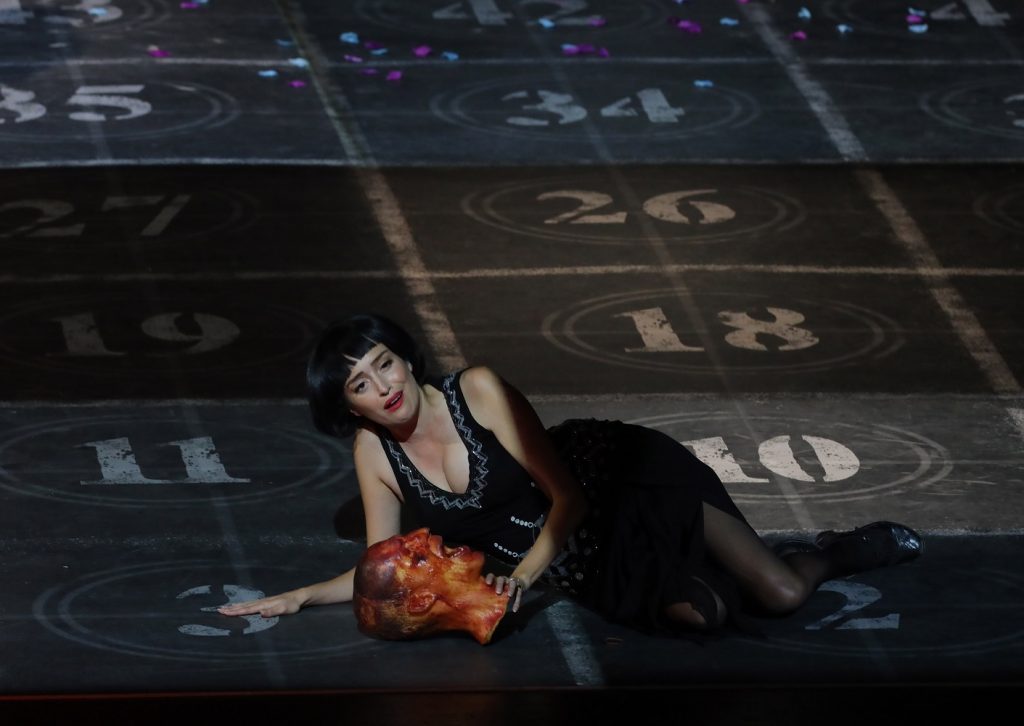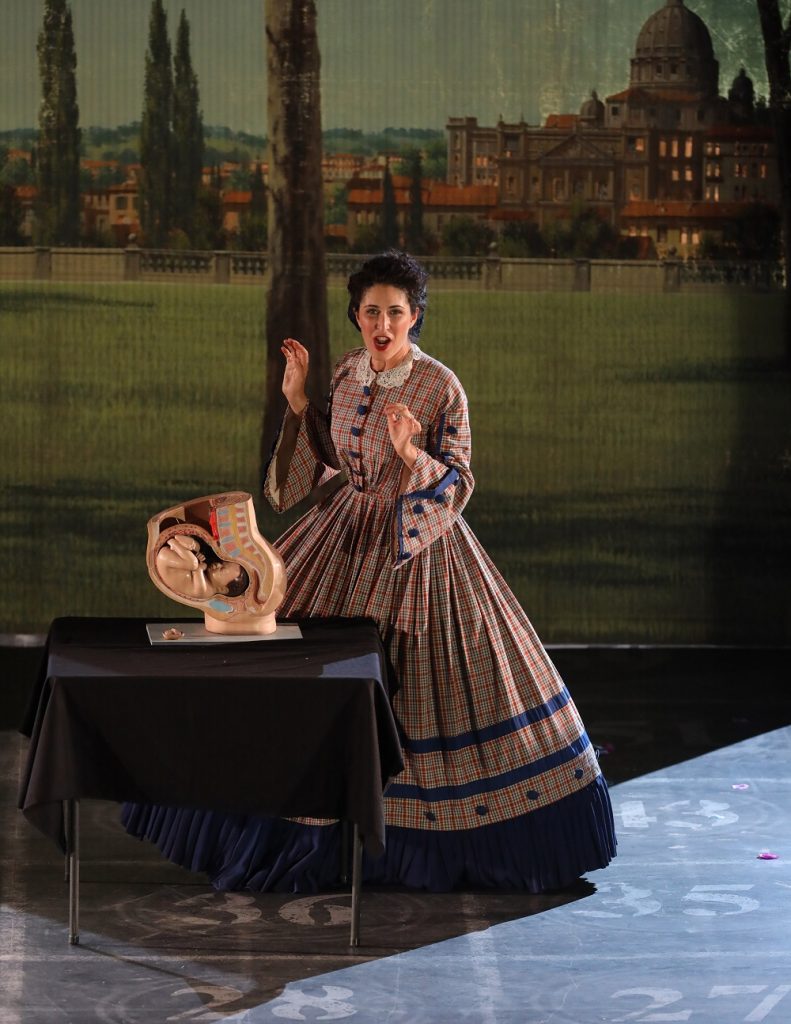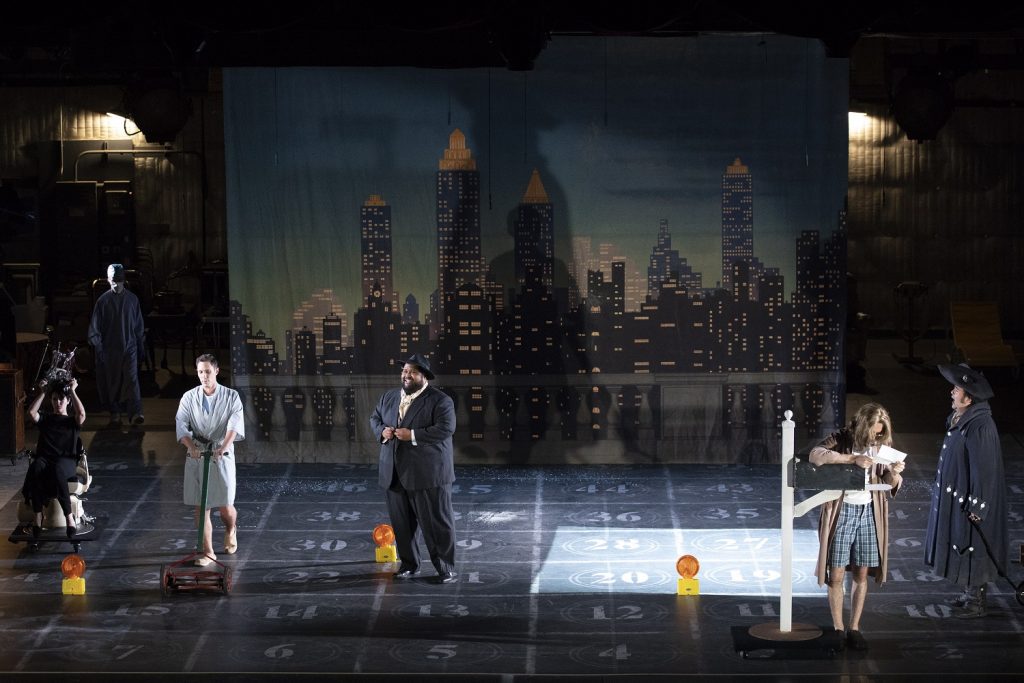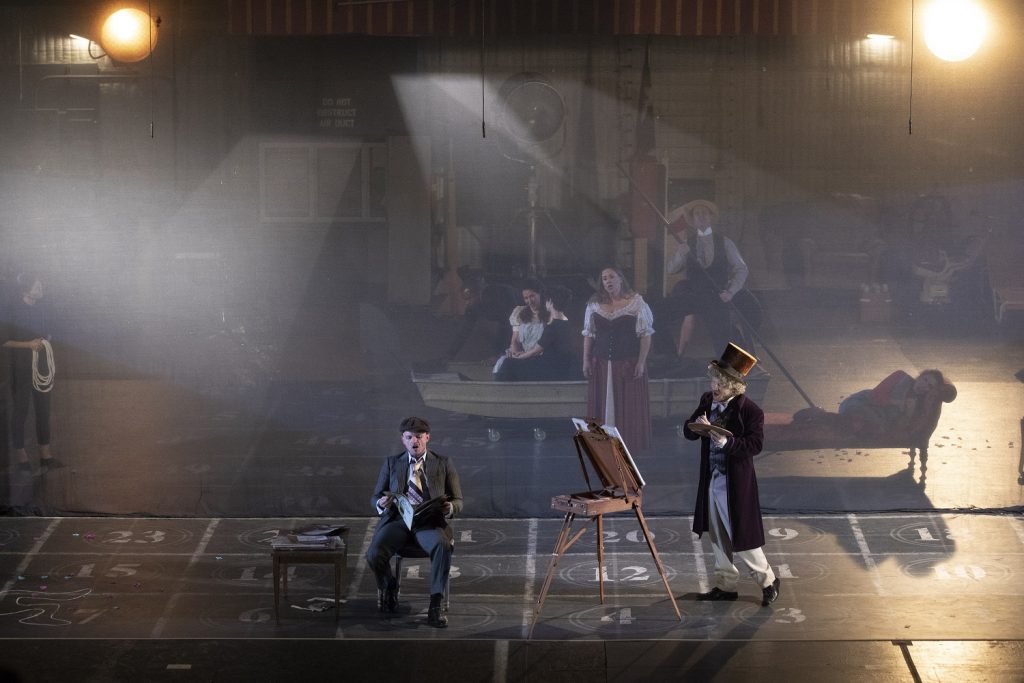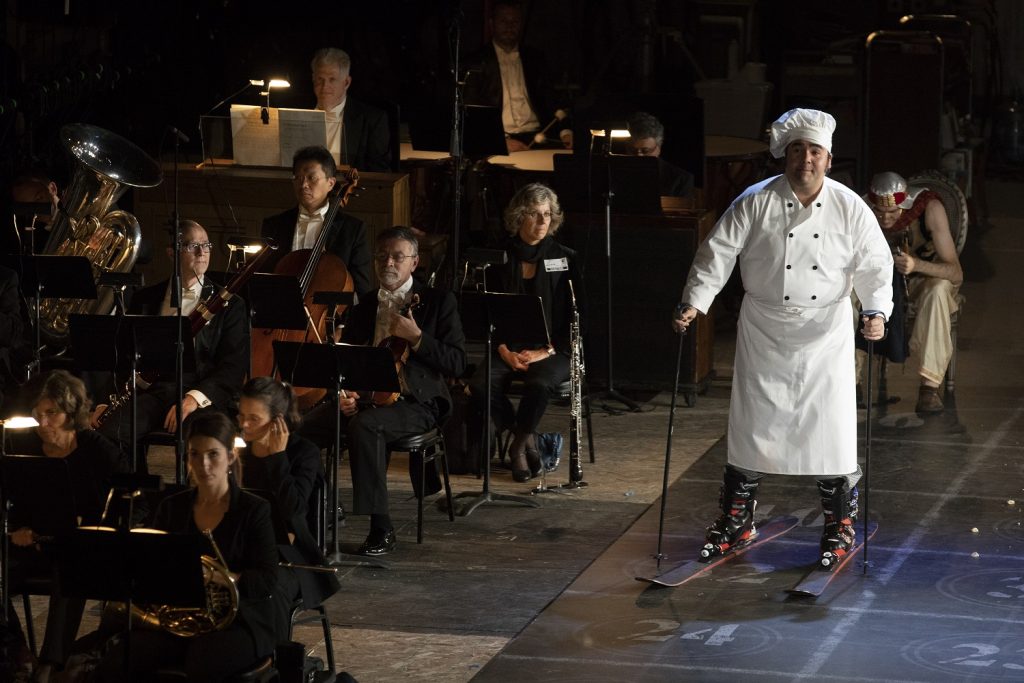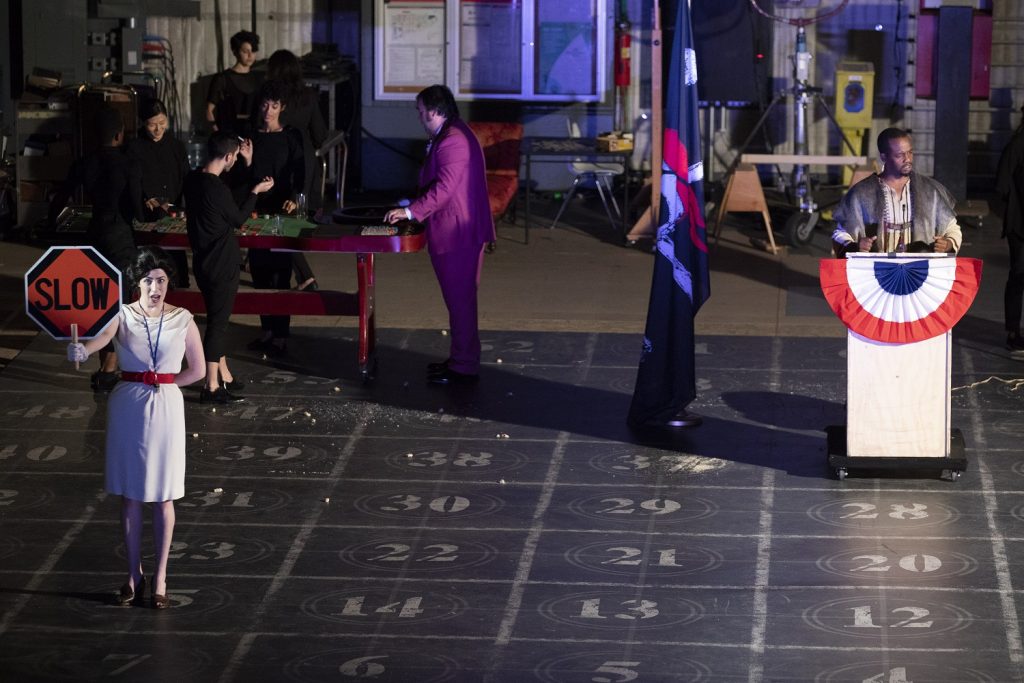As part of FLUXUS Festival, the LA Phil New Music Group presented Europeras 1 & 2 at the Sony Pictures Studios in Culver City on Wednesday, November 6, 2018, with following performances on November 10 and 11. Directed brilliantly by artist-collaborator Yuval Sharon, the performance took place in Sound Stage 23, a high-ceiling, cavernous space equipped with a temporary stage and bleachers. The orchestra was divided and lined along each side of the stage, with a bright red opera house style curtain hung in front.
Europeras I & II was written by the composer who many consider the father of electronic music, John Cage and first performed by the Frankfurt Opera in December of 1987. It was commissioned as part of the celebration of Cage’s 75th birthday. An avid student of the I Ching and a pioneer in the techniques of indeterminacy, Cage divided the stage into 64 quadrants, incorporated 19 singers, 6 dancers and what felt like an endless assortment of scenic drops, costumes, lighting shifts and whimsically used props arranging from a funeral casket to an old-fashioned bike called ordinaries in the 1980s and ’90s. Represented throughout the evening were a total of 113 operas. The 19 singers not only sung beautifully against Cage’s dissonant and sometimes loud music, but they acted out their roles with sincerity and professionalism as well as a requisite sense of humor.
Large digital clocks were positioned at key points in the room to help the performers keep track of time. Like his partner and colleague Merce Cunningham, Cage was interested in the different elements of his work sharing and being unified by time and space. With Cunningham, the dance and music were connected primarily, if not solely, by the length of the works, and they occurred within the same space or venue. There was no conductor for Europeras 1 & 2 and the same rules of engagement were evident. The musicians, the singers and the dancers each had a time period or schedule that they followed within the score, the arias, the staging and the dance solos. Time was their guide; Sound Stage 23 was their space.
Even if you do not attend with a strong knowledge or love of opera, or the music for which John Cage is so well known, there was an abundance of visual stimulation, humor and irony packed into this stimulating production to help navigate through the 90 minutes of Europeras 1 and the 45 minutes of Europeras 2 separated by a 20-minute intermission. I was pleasantly surprised that the vast majority returned for Europeras 2 considering how Cage’s music sometimes sent audiences fleeing from Cunningham concerts.
Where one sat in the audience dictated what one saw and how one saw it. Scenic backdrops continuously flew in and out, blocking off large areas of the space. Wait two minutes, however, and it all shifted again. Cage said, “What I wanted to do was to have the programs such that if twelve people were sitting in a row each one would be looking at a different opera.” I read that to make this even more inevitable, he passed out “separate sets of librettos to the audience at the premiere, themselves culled from previous operatic works”. Indeed, the synopses insert in my program was different than the one in my partner’s program.
Cage often toured with Merce Cunningham’s dance company when I was also a member of the company. I had the honor to get to talk with him, share meals and to watch him work. Aside from his musical genius and intellect, Cage had an amazing sense of humor and an infectious laugh. That wit shines throughout Europeras 1 & 2 in tandem with his vast knowledge of music, history and the world. Cage could carry on an in-depth conversation with almost anyone on just about any subject. Here, he pokes fun at the art of Opera while clearly demonstrating his knowledge and respect for the genre. As Cage described it, “For two hundred years the Europeans have been sending us their operas. Now I’m sending them back.” He did so with a jam-packed production of arias, theater and dance.
Lights focused on one quadrant and then quickly highlighted as many as 15. They sometimes danced around the stage as white specials or dazzled like disco lights in shades of blue and purple. Singers performed separately, but sometimes as many as four arias were sung in as many languages. It was an cornucopia of the senses. Also, their costume and props had little to do with the opera that was being represented. Examples: A female singer performed her aria dressed as a cowgirl. Another woman sang while holding a long narrow net to catch a “fish” wearing an opalescence unitard and swim cap. We witnessed a nun carrying a surf board, a man dressed as an astronaut lying on a bed, and a woman dressed as a restaurant server wearing a welder’s face guard hammering away at a horseshoe.
The list of ironic and humorous juxtapositions of costumes and props to arias was as long as the list of operas. We saw Cleopatra, a Samurai, Genghis Khan, Anna Leonowens and the King of Siam from The King and I, and a man in drag burning her bra. The audience chuckled at some of these and laughed out loud at others. A few pointed out Cage’s affinity towards anarchy. Obviously, Cage left the options open for the subject matters used in the productions to accommodate times like those we are currently experiencing. He certainly challenged one’s concept of what opera was and opened doors for it could be in the future.
All these characters wove their way around shifting drops with painted scenes of deserts, ancient and modern cities, mountains, hallways, buildings, familiar and unfamiliar vistas, famous paintings and much more. There were two florescent light sculptures that flew in and out, as well as a very large movie set flood light. The entire production was so well choreographed and directed that at no time was there ever a hint of collision between performer, sets or flying scenery. I am certain that the numbered square quadrants and Cage’s timed instructions helped to maneuver around the space, but it was abundantly clear that this work was beautifully rehearsed.
The dancers, costumed in all black, each had brief solos that did and did not relate to what else was transpiring onstage. They took on the jobs of stage crew to carry props and sets on and off stage as well as those of actors performing scenes with the singers. One example was Andrew Pearson portraying a Yoga instructor with a somewhat reluctant female student. He also took part in a scene with a bathroom toilet that must be experienced to fully appreciate. The other very talented dancers from varying backgrounds included Richard Biglia, Liz Bustle, Raymond Ejiofor, DaEun Jung, and Eden Orrick.
I will not spoil the fun for those who plan to attend the performance of Europeras 1 & 2 this coming Saturday and Sunday, November 10 and 11. If you have not experienced John Cage, enter with an open mind and be ready to “go with the flow”. Leave your preconceived notions of music and opera at the door and let yourself be absorbed into the wonderful, irritating, confusing, funny and entertaining world of Cage’s complex mind.
The entire production staff did a fantastic job of creating a parallel universe for Cage’s operatic vision. They were Yuval Sharon, director; John Iacovelli, scenic design; Marc Lowenstein, music advisor; Chris Kuhl, lighting designer; Emma Kingsbury, costume designer; Jody Elff, sound designer; and Alexander Gedeon, associate director.
The talented and versatile singers were Maria Elena Altany, soprano; Justine Aronson, soprano; Julianna Di Giacomo, soprano; Sara Hershkowitz, soprano; Laurel Irene, soprano; Sarah Beaty, mezzo-soprano; Suzanna Guzmán, mezzo-soprano; Joanna Lynn-Jacobs, mezzo-soprano; Renée Rapier, mezzo-soprano; Ashley Faatoalia, tenor; Jon Lee Keenan, tenor; James Onstad, tenor; Babatunde Akinboboye, baritone; David Castillo, baritone; David Williams, baritone; Cedric Berry, bass-baritone; James Hayden, bass; and Colin Ramsey, bass.
The extraordinary musicians of the LA Phil included Nathan Cole, Mark Kashper, violins; Dale Hikawa Silverman, viola; Ben Hong, cello; Christopher Hanulik, bass; Catherine Ransom Karoly, Elise Shope Henry, Diane Alancraig, flutes; Ramón Ortega, Anne Marie Gabriele, Carolyn Hove, oboes; Boris Allakhverdyan, Andrew Lowy, David Howard, clarinets; Whitney Crockett, Michele Grego, bassoons; Jaclyn Rainey, Gregory Roosa, horns; James Wilt, Christopher Still, trumpets; David Rejano Cantero, James Miller, John Lofton, trombones; Scott Sutherland, tuba; Joseph Pereira, timpani; James Babor, percussion; and Gavin Martin, Mark Robson, keyboards.
For more information and to purchase tickets for Europeras 1 & 2, click here.
For information on FLUXUS, click here.
Featured image: FLUXUS: Cage’s Europeras 1&2 @ Sony Pictures Studios Photo Credit: Craig T. Mathew/Mathew Imaging
Promotion trailer for Europeras 1 & 2






